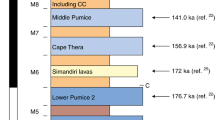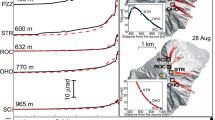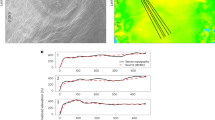Abstract
In 2005, plumes were detected near the south polar region of Enceladus1, a small icy satellite of Saturn. Observations of the south pole revealed large rifts in the crust, informally called ‘tiger stripes’, which exhibit higher temperatures than the surrounding terrain and are probably sources of the observed eruptions2. Models of the ultimate interior source for the eruptions are under consideration1,3,4,5. Other models of an expanding plume6 require eruptions from discrete sources, as well as less voluminous eruptions from a more extended source, to match the observations. No physical mechanism that matches the observations has been identified to control these eruptions. Here we report a mechanism in which temporal variations in tidal stress open and close the tiger-stripe rifts, governing the timing of eruptions. During each orbit, every portion of each tiger stripe rift spends about half the time in tension, which allows the rift to open, exposing volatiles, and allowing eruptions. In a complementary process, periodic shear stress along the rifts also generates heat along their lengths7,8,9, which has the capacity to enhance eruptions. Plume activity is expected to vary periodically, affecting the injection of material into Saturn’s E ring10 and its formation, evolution and structure. Moreover, the stresses controlling eruptions imply that Enceladus’ icy shell behaves as a thin elastic layer, perhaps only a few tens of kilometres thick.
This is a preview of subscription content, access via your institution
Access options
Subscribe to this journal
Receive 51 print issues and online access
$199.00 per year
only $3.90 per issue
Buy this article
- Purchase on Springer Link
- Instant access to full article PDF
Prices may be subject to local taxes which are calculated during checkout



Similar content being viewed by others
References
Porco, C. C. et al. Cassini observes the active south pole of Enceladus. Science 311, 1393– 1401 (2006)
Spencer, J. R. et al. Cassini encounters Enceladus: background and the discovery of a south polar hot spot. Science 311, 1401– 1405 (2006)
Nimmo, F. & Pappalardo, R. T. Diapir-induced reorientation of Saturn’s moon Enceladus. Nature 441, 614– 616 (2006)
Collins, G. & Goodman, J. C. Internal melting and the shape of Enceladus. AAS/Division Planet. Sci. Conf. 38, abstr. 18.03 (American Astronomical Society, 2006)
Kieffer, S. et al. A clathrate reservoir hypothesis for Enceladus’ south polar plume. Science 314, 1764– 1766 (2006)
Ingersoll, A. P., Porco, C. C., Helfenstein, P., West, R. A. & the Cassini ISS Team Models of the Enceladus plumes. AAS/Division Planet. Sci. Conf. 38, abstr. 15.02 (American Astronomical Society, 2006)
Nimmo, F. & Gaidos, E. Strike-slip motion and double ridge formation on Europa. J. Geophys. Res. 107 doi: 10.1029/2000JE001476 (2002)
Prockter, L. M., Nimmo, F. & Pappalardo, R. T. A shear heating origin for ridges on Triton. Geophys. Res. Lett. 32 doi: 10.1029/2005GL022832 (2005)
Nimmo, F., Spencer, J. R., Pappalardo, R. T. & Mullen, M. E., Shear heating as the origin of the plumes and heat flux on Enceladus. Nature doi:10.1038/nature05783 (this issue).
Horanyi, M., Burns, J. A. & Hamilton, D. P. The dynamics of Saturn’s E ring particles. Icarus 97, 248– 259 (1992)
Giese, B., Roatsch, T., Wagner, R., Denk, T. & Neukum, G. Topographic models of the icy Saturn satellites. Eur. Planet. Sci.Congr. abstr. 119. (2006)
Sohl, F., Hussmann, H. & Ziethe, R. Interior structures of Enceladus and Mimas: implications from their densities and equilibrium shapes. AAS/Division Planet. Sci. Conf. 38 abstr. 24.01 (American Astronomical Society, 2006)
Hussmann, H., Sohl, F. & Grott, M. Tidal heating in Enceladus And Mimas: implications for their thermal and orbital states. AAS/Division Planet. Sci. Conf. 38, abstr. 24.02 (American Astronomical Society, 2006)
Hurford, T. A. Tides and Tidal Stress: Applications to Europa. PhD thesis, Univ. Arizona. (2005)
Melosh, H. J. Global tectonics of a despun planet. Icarus 31, 221– 243 (1977)
Leith, A. C. & McKinnon, W. B. Is there evidence for polar wander on Europa? Icarus 120, 387– 398 (1996)
Gammon, P. H., Kiefte, H., Clouter, M. J. & Denner, W. W. Elastic constants of artificial and natural ice samples by Brillouin spectroscopy. J. Glaciol. 29, 433– 460 (1983)
Hoppa, G., Tufts, B. R., Greenberg, R. & Geissler, P. Strike-slip faults on Europa: global shear patterns driven by tidal stress. Icarus 141, 287– 298 (1999)
Hoppa, G. V., Greenberg, R., Tufts, B. R. & Geissler, P. E. Plume detection on Europa: locations of favorable tidal stress. Lunar Planet. Inst. Conf. 30, abstr. 1603. (1999)
Porco, C. et al. Enceladus’ jets: particle characteristics, surface source locations, temporal variability, and correlations with thermal hot spots. Lunar Planet. Inst. Conf. 38, abstr. 2310. (2007)
Roatsch, T. et al. High resolution Enceladus atlas derived from Cassini-ISS images. Planet. Space Sci. (submitted).
Hurford, T. A., Greenberg, R. & Hoppa, G. V. South polar cycloidal rift on Enceladus. AAS/Division Planet. Sci. Conf. 38, abstr. 18.04 (American Astronomical Society, 2006)
Hoppa, G. V., Tufts, B. R., Greenberg, R. & Geissler, P. E. Formation of cycloidal features on Europa. Science 285, 1899– 1902 (1999)
Acknowledgements
This work was supported by the NASA Posdoctoral Program (NPP) under the administration of Oak Ridge Associated Universities (ORAU).
Author information
Authors and Affiliations
Corresponding author
Ethics declarations
Competing interests
Reprints and permissions information is available at www.nature.com/reprints. The authors declare no competing financial interests.
Supplementary information
Supplementary Information
This file contains Supplementary Discussion and Supplementary Figures S1-S2 with Legends. (PDF 1196 kb)
Supplementary Video 1
This file contains Supplementary Video 1 which corresponds to Figure S2 in Supplementary Information file. (MOV 609 kb)
Rights and permissions
About this article
Cite this article
Hurford, T., Helfenstein, P., Hoppa, G. et al. Eruptions arising from tidally controlled periodic openings of rifts on Enceladus. Nature 447, 292–294 (2007). https://doi.org/10.1038/nature05821
Received:
Accepted:
Issue Date:
DOI: https://doi.org/10.1038/nature05821
This article is cited by
-
Sustained and comparative habitability beyond Earth
Nature Astronomy (2023)
-
Enceladus as a potential oasis for life: Science goals and investigations for future explorations
Experimental Astronomy (2022)
-
A measurement of water vapour amid a largely quiescent environment on Europa
Nature Astronomy (2019)
-
Cascading parallel fractures on Enceladus
Nature Astronomy (2019)
-
Timing of water plume eruptions on Enceladus explained by interior viscosity structure
Nature Geoscience (2015)
Comments
By submitting a comment you agree to abide by our Terms and Community Guidelines. If you find something abusive or that does not comply with our terms or guidelines please flag it as inappropriate.



